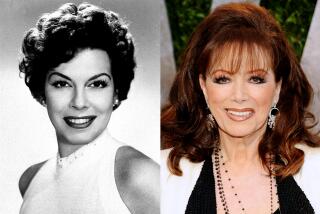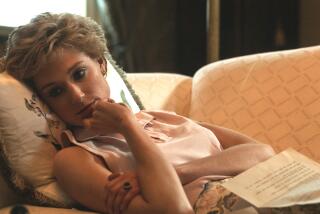‘Diana,’ the real and imagined
- Share via
I just finished reading Tina Brown’s new book, “The Diana Chronicles,” and I think I’m going to the chiropractor now.
I read every whiplash chapter and came away rubbing my cervical vertebrae. This book is the closest I’ll ever get to knowing Diana, the late Princess of Wales: a woman mesmerizing and charming one moment, manipulative and calculating the next ... all affection and confiding phone calls one week, and the next, the coldest, best-dressed shoulder in England.
“The Diana Chronicles,” Brown’s account of the young aristocrat’s marriage to the heir to the throne, motherhood, divorce and death, has enough of Diana’s hairpin personality turns, emotional drops and gleeful summits to be a Disneyland thrill ride: Indeed, Diana’s press officer once said that her office’s mission was being “like Disney -- to bring happiness to people.”
Did Diana really not remember -- or never know -- that one was a magic kingdom, a business gilded by fantasy, and the other one -- the one she could have been queen of -- was a real kingdom, and also, in its own way, a business gilded by fantasy?
In Brown’s account, Diana’s fantasies and realities, sadly, never did disentangle themselves, from Diana’s nine-alarm answer -- “What’s the difference?” -- to her mother’s question about whether she loved Charles or his title, to her last fling with Dodi Fayed, whose 0-out-of-100 unsuitability she used to torment her tormentors, to her own delusional mythmaking: She told Brown that she thought she could work out the conflicts in Northern Ireland because “I’m very good at sorting people’s heads out.” But on the same page, as Brown notes, a woman “so sensitive to the needs of others” was “strangely blind when it came to those closest to her” -- starting with herself.
Brown opens her adroit and penetrating book with a nod to the August 1997 death in the Paris tunnel, then casts back to her lunch with Diana in New York the month before, when Diana’s chatter about moving to America showed an instinct “dead on. She would only ever feel at home now in the culture that invented fame the size of hers.”
The lunch scene serves too to remind us of Brown’s stature: She is an insider, no rat-packer trailing after Diana leftovers, and she cements it with her extensive interviews, some with people who speak about Diana publicly for the first time.
In the last days of her life, Brown writes, Diana was casting about for a “superstar’s version” of her former royal existence. Her public crusades, like calling for an international landmine ban, earned her immense plaudits, but her private life was in disarray. Having abandoned her Marie Antoinette-like delusions of disappearing into a Sussex cottage, she was keeping her lines baited for others, among them American financier Teddy Forstmann, who told Brown that the “unhappy” Diana “had the idea that we should get married, that I should run for president and she would be First Lady.”
Diana cast her spell most consistently with strangers, in those causes that absorbed her so passionately. Brown reminds us of her instantly intimate, magical presence -- as if from an age when sovereigns ruled by divine right. When the Divine Diana showed up at a home for disabled adults, a no-nonsense consultant said that “it was as if everyone there that morning had been touched by light.” Ours is not the age of Elizabeth the Great but of Oprah the Consoler, and Diana was its apogee.
Even before Diana’s first encounter with Prince Charles (they were alone together only 13 times before their wedding, Brown tells us), her life was, from her poor-little-rich-girl childhood, a series of starring performances in serial fantasies -- protective cocoons that in the end never protected her, nor prepared her for disappointment when each fantasy collapsed.
Brown doesn’t spare the royals -- not the mercurial Prince Philip, who referred to his daughter-in-law as a “fifth columnist,” nor the Prince of Wales, whose beloved nanny, Brown tells us, “was the spitting image of Camilla Parker Bowles,” a woman who was not so cavalier about Charles’ affection as some might have thought.
Diana’s famous line from her disastrous television interview, that there were three in her marriage, is true -- but the third, I would suggest, was the press. Diana from the very first showed her canniness, watching paparazzi from a makeup mirror from behind a tree as Charles fished. In another life, her media skills would have earned her millions. As it was, they earned millions for others, and brought her to grief.
She outwitted herself, in the end, cooperating in a tell-all book and then lying about it, making phone calls to summon the press when she wished to be seen -- and ultimately being pursued by the ravenous creature she had helped to create. Brown believes it was Diana who callously threw her sister-in-law Sarah Ferguson to the press wolves, as the only person besides Sarah’s bodyguard who knew where she would be with her toe-sucking business advisor -- all to throw the press off Diana’s own disastrous “Squidgygate” taped phone intimacies. “She had done such things before,” Brown writes.
Diana’s husband and in-laws were rank amateurs at this game. The royal family comes across as stodgy and hidebound, but so isolated as to know nothing else. When Diana wonders in 1985, “Did Joan Collins’ wedding kick me off the front page?” we realize that a true royal wouldn’t care -- or notice. The queen disdains “stunts,” and, for her, royal appearances, writes Brown, are not “personal performances” but “acts of state, symbolic assertions of national identity,” above ratings or reviews, while “the world the Princess of Wales inhabited was applause.”
The end of August marks 10 years since Diana died. I covered her funeral; I remember London, vast and silent but for the sounds of the gun carriage with her coffin, the soldiers’ boots, the whirring wings of startled pigeons, and women’s voices above the muffled sobs wailing, like some Greek chorus, “Dianaaaaaaaaa.”
And I remember Diana’s brother’s “reckless eulogy,” one that would have cost him his head in an earlier age. Would Diana have given it herself? Brown asks. Yes -- and then she would have fired everyone who helped her write it. Diana, dead, achieved something she “could never quite manage in her lifetime: she made the Palace listen to her,” Brown writes.
There’s an uncharacteristic moment in the book in which Diana tells a tabloid editor over lunch, “Oh God, let’s face it, even I have had enough of Diana now -- and I am Diana.” It reminded me of another blond icon, likewise dead in her 30s, asking a friend, “Would you like to see me do ‘her’?” The onetime Norma Jean Baker put on the character of Marilyn Monroe, pout and swivel and all.
Even Marilyn knew the difference. Maybe that was Diana’s tragedy -- that she didn’t know, or didn’t acknowledge, any difference between the real and the make-believe.
More to Read
Sign up for our Book Club newsletter
Get the latest news, events and more from the Los Angeles Times Book Club, and help us get L.A. reading and talking.
You may occasionally receive promotional content from the Los Angeles Times.











